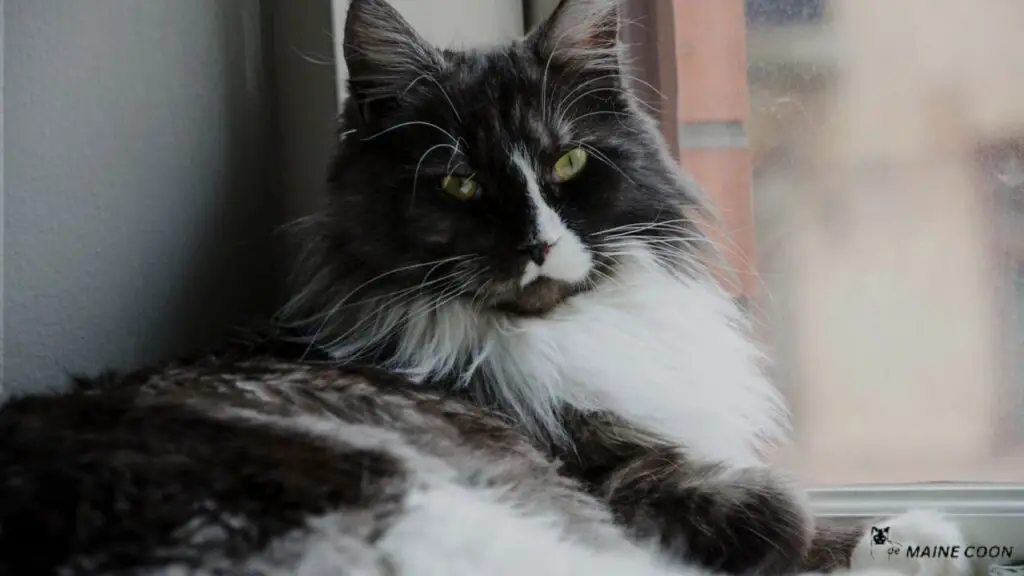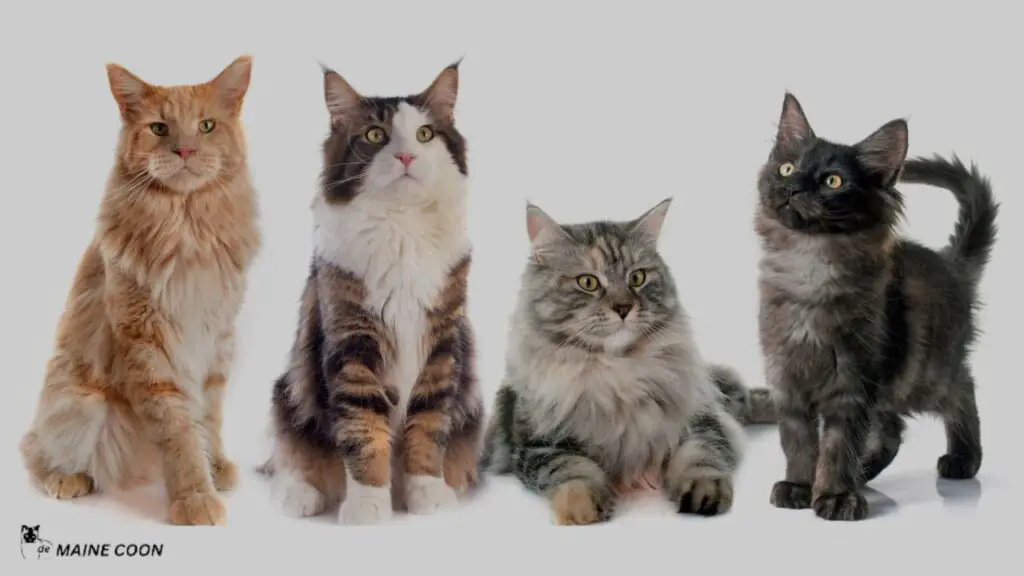Polydactyl Maine Coon: Everything You Need to Know

What Is Polydactyl?
Polydactyls are individuals, typically animals, that have more toes and fingers than usual. They display a condition where there are extra toe digits beyond what’s normal. This condition occurs in various types of animals. This condition also adds to the special and distinct appearance of the animals.
What Are Polydactyl Maine Coon Cats?
A polydactyl Maine Coon is a special type of Maine Coon with extra toes. They are commonly called “double-paws” because their feet are larger. These larger paws help them walk easily through the snow.
Sometimes they are also called “snowshoe cats.” Some people also call them “polys.” A gene called “Pd” is responsible for extra toes and it is not connected to any other special traits. If you want a polydactyl kitten, one of its parents should be polydactyl.
Extra toes don’t create any problems in Maine Coon cats. Many people also think that it improves their health and energy. If you look at the pedigree, you will see a “P” written in Polydactyl Maine Coon’s name. Even if a Maine Coon is not polydactyl, there might still be some cats in their family history that are polydactyl.
History Of Polydactyl Maine Coon
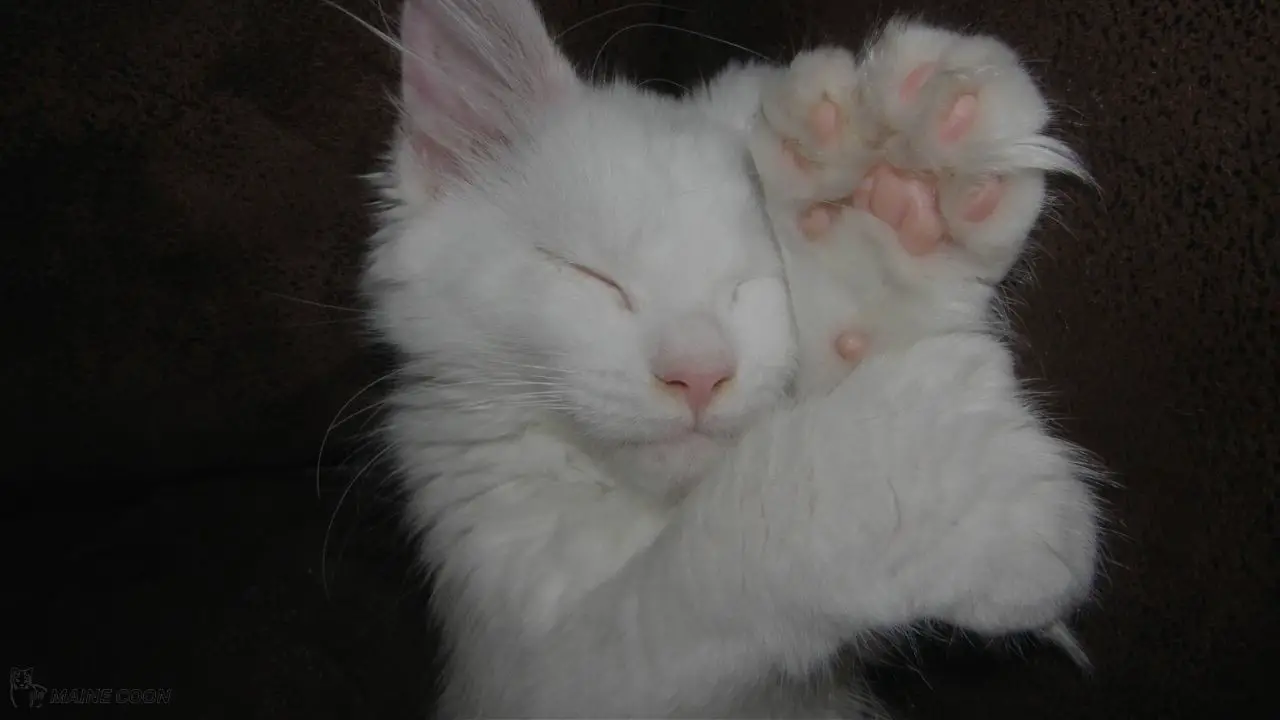
The history of these cats can be traced back to the days when families used boats for settlement. The Maine Coon cat breed started in coastal areas because of the ship cats returning home. Polydactyl cats were also fundamental for managing rodents on farms and ships.
During this period polydactyl gene became a part of the Maine Coon breed, making it a pure and special type of cat. The polydactyl Maine Coon’s larger feet not only help them in survival but also enhance their intelligence.
The Maine Coon got the name of a legendary breed due to its ability to adapt to the cold weather. Even today, some Maine Coon cats have the extra toe gene, indicating a connection to the days when people sailed with Maine Coons.
Polydactyl Maine Coons tell a tale about families who sailed on ships, shipyards, and the coastal areas where this special type of cat originated. They are like a memory of old sailing days.
Paws Information
When checking a paw to count the digits, make sure to look at the bottoms of each foot, attentive to the paw pads, toes, and nails. By looking at all these things, it becomes easy to decide if a polydactyl has extra toes, dew claws, or thumbs, creating a new paw shape.
Type of Paws
There are two types of paw formations. The reason for these two types of paw formation is likely to result from different genetic mutations causing the polydactyl trait.
- The Mitten paw
- The Patty or Snowshoe paw
The Mitten Paw
The mitten paw is named because it looks like a mitten with a thumb, usually having at least one or more dew claws. Such as four toes, a smaller dew claw, a thumb, and another dew claw. This specific configuration is frequently caused by a point mutation called “Hw.”
It was named “Hw” because of its presence in the Hemingway Cats of Florida, United States. It’s also observed in the Pixie Bob cat breed and the Pedigree Maine Coons.
The Patty Paw (Snowshoe paw)
The row of circular toes next to each other creates a big paw without a distinct thumb. This variant was first noticed in France In 2011. Even though it hasn’t been identified and precisely localized, this type of paw appears to operate in the same way as the Hw variation, resulting in a patty paw look with six digits.
In some documented cases, this variant has resulted in six-digit mitten kittens. This variant doesn’t have an official name but people called it the Canadian variant because it was first noticed in a Maine Coon foundation cat in 1992 in Manitoba, Canada.
Dirigo Poly Maine Coon
In 1988, the Dirigo polydactyl Maine Coon started with a visit to a historical settlement near the Kennebec River in Augusta, Maine, a few miles away from our nearby hometown. We got a cat with extra toes and her male kitten there.
The kitten had a brown color with four large paws. We named the cat Tuffy of Dirigo, she was so named for biting the policeman who saved her from under a riverside building. The boy kitten, called Dirigo’s Wild Native Hooch, returned to Dirigo to become a part of our breeding group.
Registered in CFF, the boy kitten smoothly joined in and every kitten he fathered was as healthy as could be. We adored the ones with his large feet, about 25% for being smart, loving, and well-defined colorations on fur.
A notable female cat named Dirigo’s “Hooch P. Honey” was born in 1991, a four-footed poly with large feet inherited from her father. Later she mated with well-known Dirigo male, TICA and CFF CH Dirigo Swift River Ruffian, and her son, Dirigo Amos P. was born in the fall of 1995.
Amos is famous for his loving nature and personifies the qualities of Maine Coon over the centuries. Owning a polydactyl Maine Coon from the Kennebec River links you to a genetic lineage that goes back hundreds of years, to the strong and original polydactyl Maine Coon.
Tuffy and her son were the first source of Polydactyl Maine Coons for Dirigo. Several years later, a second origin emerged with a Dirigo Phoebe, an amazing blue poly female. The daughter of Phoebe, Dirigo Mitsigirl P, became one of Dirigo’s best mothers, born in 1996.
She is a lovely cat with four poly feet, a lovely nature, and a sweet coat. She is great at having healthy and robust kittens. Polydactyl Maine Coons were always present in the registered breed, represented by cats like Gray Luv Perry and Whittemore Ginger.
The earlier-registered poly kittens became rare because they could not be seen. In spite of Betty Ljostadt’s support, the polydactyl trait was not included in the first breed standard due to cat politics. Because of this omittance, registered polydactyl Maine Coon led to near extinction.
Dirigo was different. They held onto the family line of polydactyl Maine Coons even when there were lesser talks and breedings due to the politics of the cat club. Passionate breeders brought back the polydactyl Maine Coon, and Dirigo was essential in introducing two sources of polydactyl Maine Coon.
Karen Jacobus boldly exhibited a poly Maine Coon as HHP, at a Maine Coon Cat Club breed show in Connecticut. This broke the ice. This cat was acquired in Augusta, Maine, the cat sent by Marty Foss to Karen. Karen registered the cat but was not bred due to the show rules.
While some other newer breeders have joined and worked with their interest in the Maine-origin polydactyl Maine Coon, nearly 20 years ago, the only polys from Maine sources including Karen’s cat and Dirigo’s cat, continue to lineage uninterrupted.
See Also: Black Smoke Maine Coon.
22 Pounds Polydactyl Maine Coon Cat
Polydactylism is a condition where cats have more toes than usual. Most of the cats have 18 fingers. But the Polydactyl Maine Coon that is featured in a TikTok by the user @Three_ mainecoons, have one or two extra toes on their front paws.
This polydactyl Maine Coon is large and fluffy, which makes it amazingly adorable. In a Tiktok video, spectators express their joy and playfully refer to Milo’s extra fingers as “murder mittens” and humorously question if it is a cat or small lion.
The cat named Milo might not go outside because of its beauty. Everyone loves Milo because of his gorgeous and amazing appearance.
What Is the Difference Between Maine Coon And Polydactyl Maine Coon
People all around the world love Maine Coon for their amazing personality and appearance. If you are thinking about the temperament difference between typical Maine Coon and polydactyl Maine Coon cats, Don’t worry.
Polydactyl Maine Coon are exactly like typical Maine Coon except one difference is that polydactyl Maine Coon have extra toes. Having extra toes doesn’t affect their personality but their paws look bigger than the size of the other Maine Coons.
Polydactyl Maine Coon have 6 to 7 fingers on each paw, the number of extra toes on each side will be the same. While typical Maine Coon cats have 5 toes on their front paw and the hind paw have 4 toes. The polydactyl Maine Coon’s front paws contain extra toes.
The Pd mutant gene in cats is responsible for the extra number of toes in Maine Coon polydactyl.
Colors Of the Polydactyl Maine Coon
Maine coon cats exist in 75 colors, even if a Maine Coon is polydactyl its color is still the same. The most common color of the polydactyl Maine Coon is classic brown or mackerel tabby and they can also come in solid-colored, bi-colored, or multi-colored.
You may also be interested in: White Maine Coon.
Personality Of the Polydactyl Maine Coon
All the Maine Coons share the same personality whether they are typical Maine Coon or polydactyl Maine Coon.
- They are quite friendly
- They behave nicely with the kids
- They are very smart
- They are loving
- They are very gentle and even-tempered
RELATED: Do Maine Coons get along with dogs?
Why Only Certain Maine Coons Are Polydactyl
Polydactylism in Maine Coon can be attributed to several factors:
- Development: Many years ago, the Maine Coon cats naturally evolved to live in the cold winters of New England. Their extra toes make their paws bigger and help them walk on cold snow without sinking. The tufts of hair on their paws protect them from the harsh cold climate.
- Hunting: These amazing cats lived in the wilderness for years. Cat experts believe that the growth of the extra toes was a part of their successful modification. Having extra toes provided these cats with better balance and made them proficient as hunters.
You may also be interested in: Russian Blue Maine Coon mix.
What Is the Current Percentage of The Polydactyl Maine Coons?
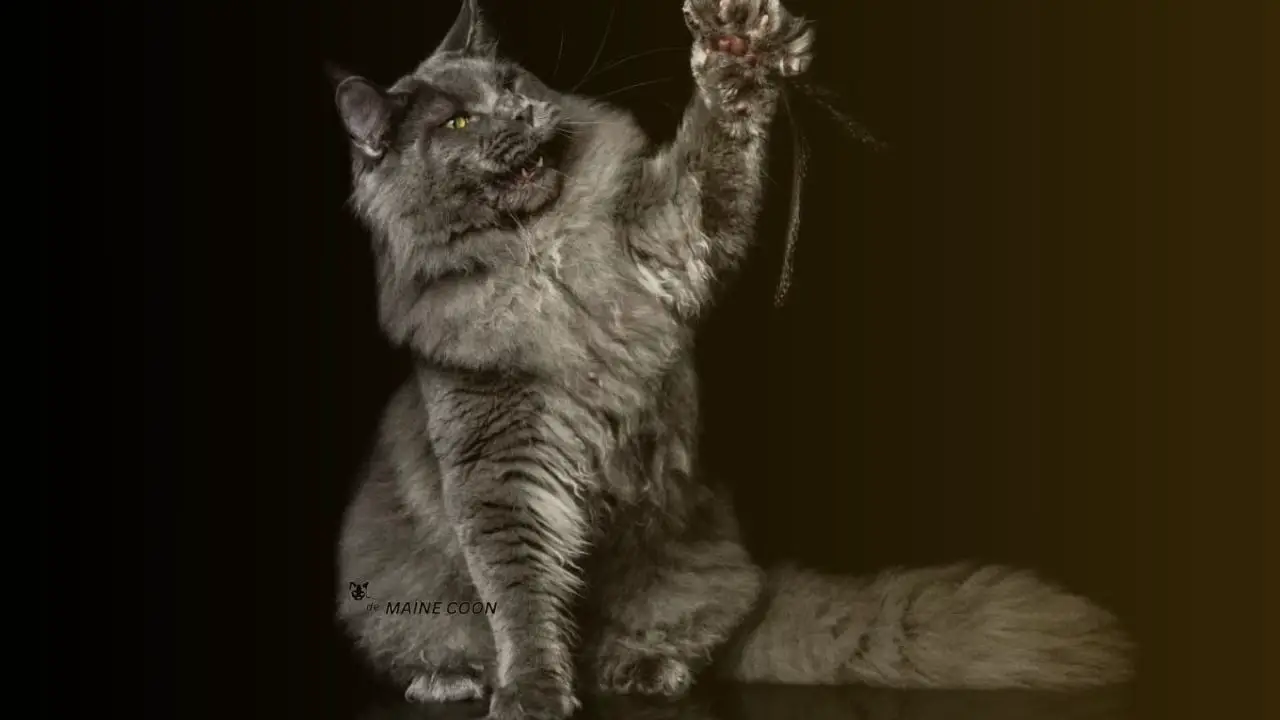
According to Beth Hicks, a study from the 1950s was conducted by a university to determine the percentage of the polydactyl Maine Coon cats. She stated from the study that about 40% of the Maine Coon were polydactyl.
Hicks noted that this percentage decreased as the Maine Coon cat returned to the show circuit. The decrease in the Maine Coon polydactyl is linked with breeders because they are making fewer polydactyl kittens and trying to follow the cat shows rules.
In spite of extensive research, we still aren’t aware of the exact current percentage of the Maine Coon polydactyl cats.
Is There a High Chance for The Female Maine Coon to Be Polydactyl
There is no preference for one gender over the other, the inherited trait found in both females and males. This means female Maine Coon cats are not more prone to be polydactyl than male and vice versa.
The gender doesn’t affect the toe numbers but is determined by the inherited trait. Polydactylism is equally displayed in both male and female cats. So, despite the gender, the chances of being polydactyl are purely based on genetics.
Do Poly Maine Coons Guarantee the Production of Polydactyl Kittens?
Polydactyl Maine is more likely to have polydactyl kittens because the polydactyl gene Pd is a dominant trait. If a polydactyl cat passes at least one replicate of the genetic mutant Pd to offspring, there is a high chance that the kitten will be polydactyl.
If two poly cats are bred, the influence of the Pd gene is firmed up, increasing the chance of the kitten being polydactyl, but there is no guarantee that they will produce a polydactyl kitten even if both the parents are polydactyl.
6 Fascinating Things to Know About Polydactyl Cats
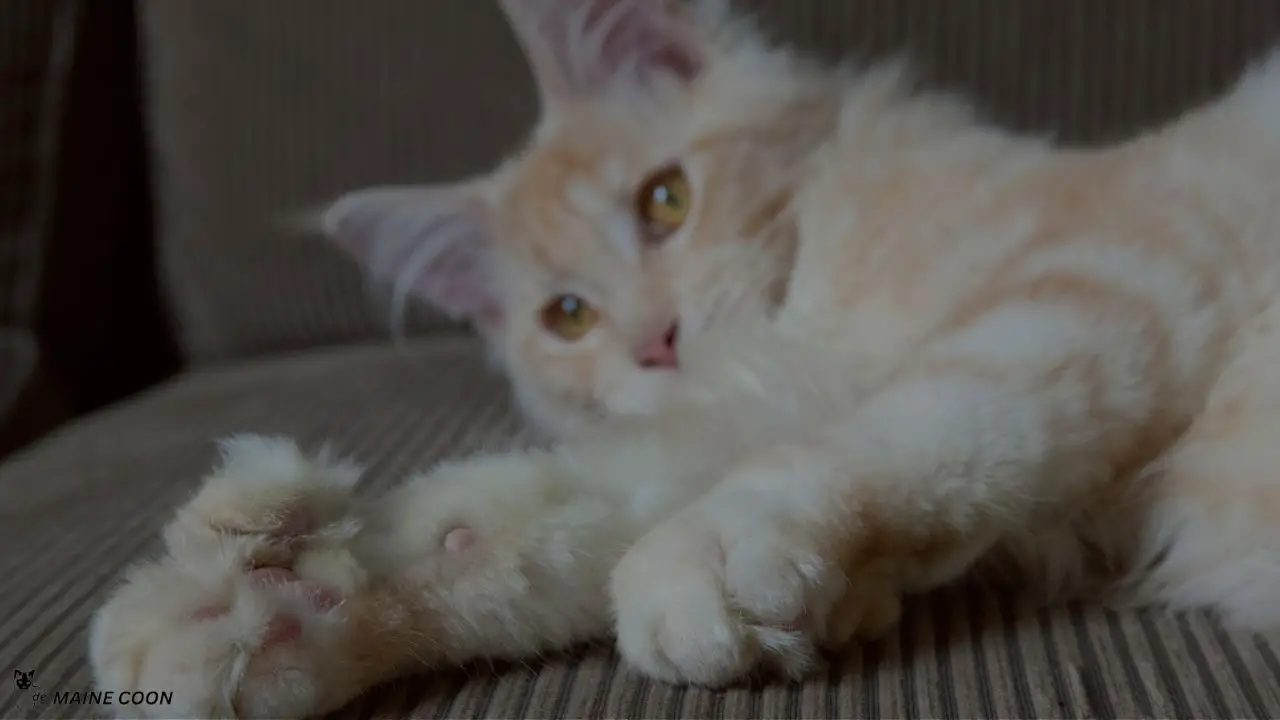
Following are some facts you need to know about polydactyl cats:
1. Polydactyl Results From The Genetic Mutation
Polydactyl is a condition caused by a genetic mutation in a dominant gene and the outcome is the formation of extra toes on kitten paws. Cats with polydactyls possess four to seven toes on their front paw. Usually, the front paws are affected by the polydactyl.
Polydactyl on all four paws is rare. There are three types of polydactyl paws:
- Mesoaxial: Extra toes are dispersed all over the paw and look like a combination of postaxial and preaxial features.
- Postaxial: Extra toes appear on the outside of the paw.
- Preaxial: Extra toes are on the inside of the paw.
Polydactyl doesn’t affect a cat’s health and wellness while it may be difficult to cut the cat’s nails. Most of the polydactyl lead healthy lives. Sometimes, people get confused between feline radial hypoplasia and polydactyl.
In feline radial hypoplasia, extra toes develop just like polydactyl but the major difference is that these extra toes grow next to their regular toes resulting in large and flat feet. Unlike polydactyl, feline radial hypoplasia appears bad for a cat’s health. If cats with feline radial hypoplasia are bred, it could cause severe paw problems in the next generation.
2. Having Extra Toes Can Be Benefit for Some Cats
The toes of polydactyl cats aren’t just cute; they also bring practical advantages to these feline friends. Due to their larger and broader paws, polydactyl cats are better able to balance on various surfaces, hunting, climbing, and capturing prey.
If you own a polydactyl cat, make sure to get a scratching post or board, and also ensure that nail trims cover all their toes. Those additional toes and claws can seriously damage your furniture, and this is also one of the behavioral problems of cats.
3. Certain Polydactyl Cats Have Cute Mitten Paws
“Mitten paws” are found in preaxial polydactyl cats, where the extra toes form in the middle of the paw, giving it a thumb-like look. While these additional digits resemble thumbs, they are not opposable.
4. Cats With Extra Toes Are Considered Lucky Charms
Similar to various cat breeds, including calico and black cats, that were thought to bring good luck to sailors, polydactyl cats are no exception. In the past, cats with extra toes were often sighted on long journeys by ship.
With the help of their broad, large paws, polydactyl cats proved to be adept mousers, ensuring the ship’s provisions remained vermin-free. Plus, their paws helped them in maintain balance on rocky seas.
Polydactyl cats are most typically discovered in Western England, Canada, Wales, and the Eastern United States, and their prevalence in these regions is often attributed to their association with trans-continental ships. It’s believed that polydactyl cats in England were transported across the Atlantic Ocean, where they mated with non-polydactyl cats, leading to the widespread inheritance of the genetic characteristic.
5. Numerous Maine Coons Often Have This Condition
Due to their origin in the harsh, snowy conditions of Maine, Maine Coon cats have evolved to have big, insulated paws that function as tiny, built-in snow boots. Luckily for Maine Coon cats, having additional toes was very usual in this breed, with around 40 percent of them having additional toes.
6. Ernest Hemingway’s Had a Fondness for Polydactyl Cats
Have you ever wondered why polydactyl cats are often called Hemingway cats? Well. It’s because Ernest Hemingway adored them. After he was gifted a white, polydactyl cat named Snow Ball by a ship’s captain, Hemingway developed a serious fondness for these cats with additional toes.
After he died in 1961, his residence in Key West, Florida underwent a transformation into a museum and a haven for his beloved cats. Presently, the kitty community at the house consists of around 50 offspring from his original pack of cats, and about half of them are polydactyl.
Guinness World Record Awarded to Polydactyl Cats
The Guinness World Record for a polydactyl cat was awarded together to two cats “Paws” and “Jake.” These cats are not from the Maine Coon breed and they have 28 toes in total.
The Lifespan of The Polydactyl Maine Coon
Maine Coon cats live around 10-15 years. Just like Maine Coon, polydactyl is expected to live as long as the other Maine Coon cats. There is no proof that they have a shorter lifespan.
How Rare Are Polydactyl Maine Coon
In the 1950s, there were 40% of the Maine Coon cats that had extra toes. Breeders prevent breeding extra toe cats to the other cats and that’s why there are not as many polydactyl cats around nowadays. CFA, the official cat registry, still doesn’t accept the polydactyl Maine Coon cats as a part of the pedigree.
Conclusion
Polydactyl Maine Coons are very eye-catching because they are multi-toed, making them look elegant. They are kind, lovely, and nice as the other Maine Coon cats. If you are thinking of owning this cat, don’t worry! They are just like other Maine Coon cats. The only difference is their extra toes.
You may also be interested in: Are Maine Coon Hypoallergenic.
Frequently Asked Questions
Do all Maine Coons possess 6 toes?
No, not all Maine Coon cats have 6 toes. Some Maine Coons are prone to a condition called polydactyl. It is not present in all the Maine Coon cats; they only contain a standard number of toes.
What makes polydactyl so popular?
Hemingway cats were famous as ship cats. Sailors started bringing them on ships. Polydactyl cats are thought to be better at climbing and catching mice than actual regular cats. Some people even believe that they bought good luck.
Is a polydactyl cat smarter?
Despite of the unique character, the polydactyl is similar to the other cats. People believe that they are more intelligent and relaxed than other cats.


